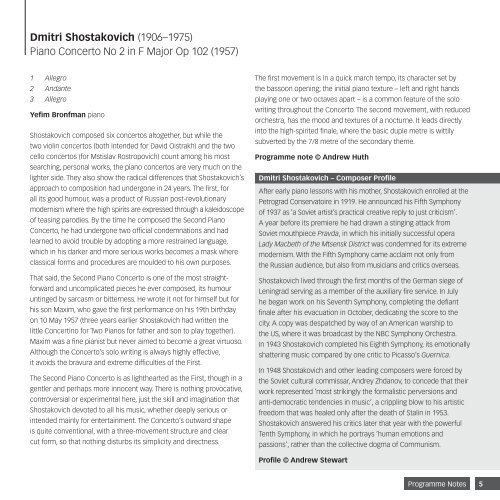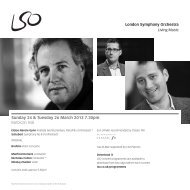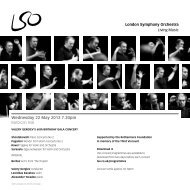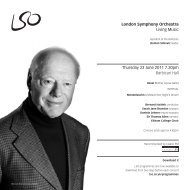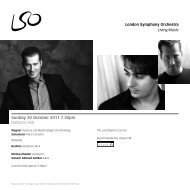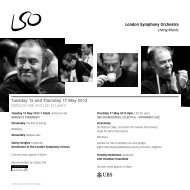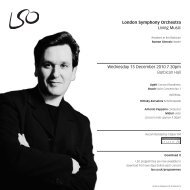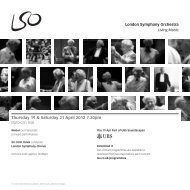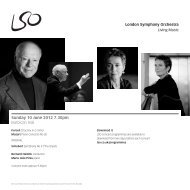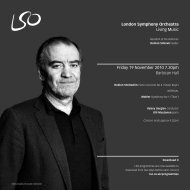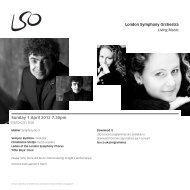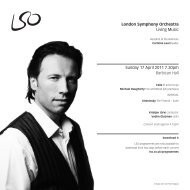Thursday 12 May programme - London Symphony Orchestra
Thursday 12 May programme - London Symphony Orchestra
Thursday 12 May programme - London Symphony Orchestra
You also want an ePaper? Increase the reach of your titles
YUMPU automatically turns print PDFs into web optimized ePapers that Google loves.
Dmitri Shostakovich (1906–1975)<br />
Piano Concerto No 2 in F Major Op 102 (1957)<br />
1 Allegro<br />
2 Andante<br />
3 Allegro<br />
Yefim Bronfman piano<br />
Shostakovich composed six concertos altogether, but while the<br />
two violin concertos (both intended for David Oistrakh) and the two<br />
cello concertos (for Mstislav Rostropovich) count among his most<br />
searching, personal works, the piano concertos are very much on the<br />
lighter side. They also show the radical differences that Shostakovich’s<br />
approach to composition had undergone in 24 years. The first, for<br />
all its good humour, was a product of Russian post-revolutionary<br />
modernism where the high spirits are expressed through a kaleidoscope<br />
of teasing parodies. By the time he composed the Second Piano<br />
Concerto, he had undergone two official condemnations and had<br />
learned to avoid trouble by adopting a more restrained language,<br />
which in his darker and more serious works becomes a mask where<br />
classical forms and procedures are moulded to his own purposes.<br />
That said, the Second Piano Concerto is one of the most straight-<br />
forward and uncomplicated pieces he ever composed, its humour<br />
untinged by sarcasm or bitterness. He wrote it not for himself but for<br />
his son Maxim, who gave the first performance on his 19th birthday<br />
on 10 <strong>May</strong> 1957 (three years earlier Shostakovich had written the<br />
little Concertino for Two Pianos for father and son to play together).<br />
Maxim was a fine pianist but never aimed to become a great virtuoso.<br />
Although the Concerto’s solo writing is always highly effective,<br />
it avoids the bravura and extreme difficulties of the First.<br />
The Second Piano Concerto is as lighthearted as the First, though in a<br />
gentler and perhaps more innocent way. There is nothing provocative,<br />
controversial or experimental here, just the skill and imagination that<br />
Shostakovich devoted to all his music, whether deeply serious or<br />
intended mainly for entertainment. The Concerto’s outward shape<br />
is quite conventional, with a three-movement structure and clear<br />
cut form, so that nothing disturbs its simplicity and directness.<br />
The first movement is in a quick march tempo, its character set by<br />
the bassoon opening; the initial piano texture – left and right hands<br />
playing one or two octaves apart – is a common feature of the solo<br />
writing throughout the Concerto. The second movement, with reduced<br />
orchestra, has the mood and textures of a nocturne. It leads directly<br />
into the high-spirited finale, where the basic duple metre is wittily<br />
subverted by the 7/8 metre of the secondary theme.<br />
Programme note © Andrew Huth<br />
Dmitri Shostakovich – Composer Profile<br />
After early piano lessons with his mother, Shostakovich enrolled at the<br />
Petrograd Conservatoire in 1919. He announced his Fifth <strong>Symphony</strong><br />
of 1937 as ‘a Soviet artist’s practical creative reply to just criticism’.<br />
A year before its premiere he had drawn a stinging attack from<br />
Soviet mouthpiece Pravda, in which his initially successful opera<br />
Lady Macbeth of the Mtsensk District was condemned for its extreme<br />
modernism. With the Fifth <strong>Symphony</strong> came acclaim not only from<br />
the Russian audience, but also from musicians and critics overseas.<br />
Shostakovich lived through the first months of the German siege of<br />
Leningrad serving as a member of the auxiliary fire service. In July<br />
he began work on his Seventh <strong>Symphony</strong>, completing the defiant<br />
finale after his evacuation in October, dedicating the score to the<br />
city. A copy was despatched by way of an American warship to<br />
the US, where it was broadcast by the NBC <strong>Symphony</strong> <strong>Orchestra</strong>.<br />
In 1943 Shostakovich completed his Eighth <strong>Symphony</strong>, its emotionally<br />
shattering music compared by one critic to Picasso’s Guernica.<br />
In 1948 Shostakovich and other leading composers were forced by<br />
the Soviet cultural commissar, Andrey Zhdanov, to concede that their<br />
work represented ‘most strikingly the formalistic perversions and<br />
anti-democratic tendencies in music’, a crippling blow to his artistic<br />
freedom that was healed only after the death of Stalin in 1953.<br />
Shostakovich answered his critics later that year with the powerful<br />
Tenth <strong>Symphony</strong>, in which he portrays ‘human emotions and<br />
passions’, rather than the collective dogma of Communism.<br />
Profile © Andrew Stewart<br />
Programme Notes<br />
5


